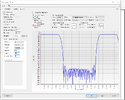Hello,
Wondering if there are any analog filters that can do this that I am not aware of. Basically we are looking for a loop pass fitler with hard cut off (like an elliptical filter) but with zero singal pass through in the stop band and also without phase shift.
We have an analog signal that we generate by stabilizing a moving object and would like to move another system in sync with that, while doing that we would like to eliminate everything above 60Hz form the signal (which we consider as noise). We have a butterworth filter from SRS, this one introduces about 180deg phase shiftdepedning on cutoff frequency and also passing an attenuated singla aobve out cutoff frequency.
Any suggestions?
thanks
Wondering if there are any analog filters that can do this that I am not aware of. Basically we are looking for a loop pass fitler with hard cut off (like an elliptical filter) but with zero singal pass through in the stop band and also without phase shift.
We have an analog signal that we generate by stabilizing a moving object and would like to move another system in sync with that, while doing that we would like to eliminate everything above 60Hz form the signal (which we consider as noise). We have a butterworth filter from SRS, this one introduces about 180deg phase shiftdepedning on cutoff frequency and also passing an attenuated singla aobve out cutoff frequency.
Any suggestions?
thanks


